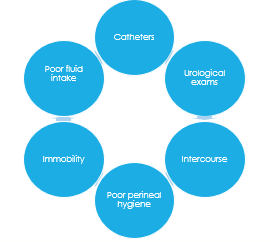10 Module 9 – Elimination
Elimination
Learning Objectives
- Demonstrate understanding of normal urination and urinary incontinence
- Demonstrate understanding of catheter care
- Demonstrate understanding of normal bowel elimination and bowel problems
- Demonstrate proper specimen collection
Urination
The urinary system
The urinary system is extremely important to a person’s overall health. It filters the blood, helps humans absorb nutrients, balances fluids, and facilitates the disposal of liquid waste. The urinary system consists of two kidneys, two ureters, the bladder, and the urethra.
Our kidneys are our body’s filters. They filter the blood so it’s free from toxins and waste, and are important for regulating the body’s mineral and electrolyte balance and fluid amount.
Our kidneys are bean-shaped, lay towards the back of our abdomens and are roughly the size of one’s palm. Kidneys filter out usable material (nutrients, minerals, etc) from liquid waste, which it then turns into urine. Kidneys then send the urine to the bladder through ureters; each kidney has its own ureter, or the tubes that carry urine from the kidneys to the bladder.
Once the urine is in the bladder it remains there until the bladder reaches a certain fullness, when the bladder will tell the brain “I’m full, please pee” and the person develops the urge to urinate.
When the person decides to release their urine then their urinary muscles relaxes and allow urine to pass through to the urethra. The urethra is the tube that runs from the bladder to the meatus, or the external urinary opening. Image by Cancer Research UK, CC BY-SA 4.0.
Healthy urination
Normal, healthy urine will mostly consist of water. It will be a pale-yellow, although its color can change depending on a person’s hydration, medications, or diet[1]. For instance, someone who eats beets may have a reddish hue to their urine; someone who has recently eaten asparagus may have urine with a pungent smell.
Urine should not be cloudy; healthy urine is clear, with a faint but discernible smell. If the NA notices that a person’s urine is cloudy right upon voiding (another word for urinating) then they should tell the nurse at once. Cloudy urine or urine with particulates indicates the possible presence of infection.
Healthy adults produce about 1500 mL (50 oz) of urine per day, though this amount can vary with age, activity levels, and health.
Urination should be painless, and should contain only urine. If the person’s urine appears to contain blood, mucus, pus, or particulate, the NA should report it to the nurse right away. Also report any strong or foul-smelling urine, painful urination, incontinence, and abnormally frequent urination.
Factors influencing urination
A person usually voids at bedtime, upon waking, and before meals. Others may urinate as frequently as every 2 – 3 hours. Some people can use the bathroom on their own, while others require assistance. NAs must always respond to bathroom requests as quickly as possible. Lots of different factors impact urinary health.
Age: As a person ages, their bladders become less flexible and their capacity diminishes. This means that older adults will need to urinate more often than they did when younger. As a person ages, they also become less likely to completely empty their bladder when voiding, which results in more frequent trips to the bathroom and heightens the person’s risk of infection. NAs should prompt residents to consume fluids and make sure that the person’s bedside water pitcher is always replenished.
If a person’s call light is on, respond as quickly as possible, since it may be a bathroom request. NAs should not expect people to “hold it,” since this is uncomfortable, undignified, and can lead to bladder infections and “accidents.”
Emotions: Stress, anxiety, and depression can all have an impact on a person’s urination. For example, a lack of privacy can lead to altered urination habits. The stress of moving into an assisted living facility and feeling uncomfortable around so many new people may cause someone to urinate more frequently in smaller amounts. Always provide privacy, exercise patience, and make sure that residents know that NAs are there to assist them in a friendly and non-judgmental way.
Thirst: Thirst diminishes as a person ages. If someone is not thirsty then they are less likely to drink, which means that their urinary system may suffer. Maintaining good hydration is necessary for the body’s ability to filter its blood. NAs should encourage people to consume water and other fluids often .
Muscles: As a person ages their muscles weaken and their muscle tone diminishes; good muscle tone is helpful for controlling the flow of urine. NAs can promote the muscular dimension of healthy urination by encouraging ambulation and other forms of exercise. Activity is important both because it helps maintain muscle tone and helps a person become thirsty.
NAs should always respond to requests to use the bathroom as quickly as possible. This is essential for preventing urinary infections. It is also important for keeping a person generally comfortable, and psychologically and emotionally well. Person-centered, holistic care requires attending to a person’s basic needs promptly.
Promptly assisting residents with their bathroom needs closely relates to all three dimensions of the Big Three. How does assisting residents with urination relate to Resident Rights, Infection Control, and Safety? Write for 5 minutes, and discuss your response with a friend or classmate.
Reporting & Recording
Reporting and recording when somebody urinates, the quality of the urine, and any other relevant details will be an important task for NAs. These are some useful vocabulary words for talking and writing about urination[2]:
- Dysuria: painful or difficult urination
- Hematuria: blood in the urine
- Nocturia: frequent urination at night
- Polyuria: voiding abnormally large amounts of urine
- Oliguria: scant amounts of urine, less than 500 mL in 24-hour period
- Urinary incontinence: losing control of one’s bladder
- Urgency: needing to void immediately
- Frequency: urinating often with little time between one voiding and the next
NAs should report and record meticulously. Healthy urination, or lack thereof, can give the care team clues as to what may be wrong with someone. It is also important to address complications with urination quickly, and to include strategies for promoting healthy urination in someone’s care plan.
Signs of unhealthy urination include: 
- swelling in the hands and feet
- painful urination
- changes in the qualities of urine
- changes in frequency or amount of urine
- abdominal swelling
- pain in the bladder area
- urinary incontinence including dribbling
- back pain, which may be related to a kidney disorder
- inadequate fluid intake Pbrundel, CC BY-SA 3.0,
If anybody in your care exhibits these symptoms, alert the nurse promptly.
Urinary Disorders
Urinary disorders are common among older adults, and vary in severity. Some especially common disorders of the urinary system include an enlarged prostate, urinary tract infections, kidney infections, kidney stones, and urinary incontinence[3].
Enlarged prostate
Benign prostatic hypertrophy commonly occurs in older persons with a penis and a prostate. It involves the enlargement of the prostate gland, located in the groin between the rectum and the base of the penis. When the prostate enlarges it squeezes the urethra and blocks the urine.
Symptoms of an enlarged prostate include:
- a weak stream when urinating
- frequent urination in small amounts
- urgency
- leaking or dribbling
- nocturia
- urinary retention or inability to void
UTIs
Urinary tract infections (UTI) occur when pathogens reproduce along the urinary system. UTIs usually begin when a pathogen enters the body through the urinary opening. UTIs are a common healthcare acquired infection (HAI), and if left untreated can lead to kidney infections and death. If a person experiences symptoms like frequent painful urination, seems confused or disoriented, or has blood in their urine, the NA should alert the nurse immediately.
When they are HAIs, UTIs are usually acquired by the use of catheters, or by bacteria acquired during urological exams. Other causes of healthcare acquired UTIs could be from poor perineal hygiene, immobility, and poor fluid intake.
Meticulous perineal care and proper catheter care are essential to preventing UTIs. A person can also develop a UTI from sexual intercourse. NAs should encourage sexually active residents to urinate shortly after intercourse to help prevent UTIs.
Treatment for UTIs always involves drinking lots of fluids, and may also involve medication.
Kidney disorders
Kidney infection
Pyelonephritis is the medical term for an infection in the kidneys. Kidney infections are serious and can be life-threatening. They are also extremely uncomfortable.
Symptoms of pyelonephritis include:
- chills
- fever
- back pain
- nausea
- vomiting
Since kidney infections can follow UTIs, looking for the symptoms of UTIs can help provide warning signs of a kidney infection. Treatments for kidney infection include powerful antibiotics and increased fluid intake.
Kidney stones
Kidney stones occur when crystals form in the kidneys, creating deposits as small as sand and as large as a golf ball. Some kidney stones will pass through the urinary system on their own, which is a notoriously agonizing process. Others require medical interventions like surgery.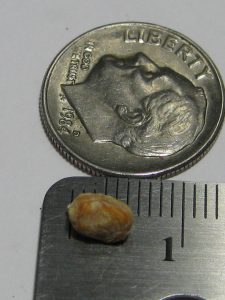
Common risk factors for calculi, the medical term for kidney stones, are bedrest, immobility, and poor fluid intake. Kidney stones most commonly occur in people over the age of 40. Symptoms of kidney stones include an intense ongoing pain that becomes worst during urination. Other symptoms include fever, chills, dysuria, and hematuria.
Treatment for kidney stones involves pain medication and increased fluid intake. It may also include straining the person’s urine to see whether the stone passes on its own. If a kidney stone is too large to pass, it may require surgery.
“Kidney Stone” by peterjr1961 is licensed under CC BY-NC 2.0.
Urinary incontinence
Urinary incontinence occurs in people when they lose control over their bladder. Urinary incontinence can occur due to paralysis, surgery, illness, and other factors. Whatever the reason, NAs must always be respectful and professional when caring for somebody experiencing incontinence.
Many people find experiencing incontinence uncomfortable and embarrassing. A person experiencing incontinence will need empathy, understanding, and reassurance. Maintain a positive attitude and respond promptly to bathroom requests or cleaning needs from residents experiencing incontinence.
Safety is an essential consideration. If somebody is incontinent, they may have an urgent need to relieve themselves; this can make a person who usually needs assistance attempt to get to the bathroom without assistance. NAs should respond to call lights from people experiencing incontinence immediately to avoid a situation where somebody tries to get to the bathroom unassisted, is forced to retain their urine for longer than is comfortable, or risks voiding while in bed.
There are six general kinds of incontinence[5]:
- Stress incontinence: incontinence due to pressure in the abdomen, caused by something like laughing, hiccupping, sneezing, or any action that causes the abdominal muscles to clench.
- Urge incontinence: accidental voiding due to a sudden urge and need to urinate.
- Mixed: incontinence as a combination of stress and urge incontinence
- Functional incontinence: urinating because of a reason other than the urinary tract, such as environmental or cognitive feature. Urinating out of fear would be an example.
- Overflow incontinence: incontinence caused by an overflowing or swollen bladder.
- Reflex incontinence: urine is lost at predicable times when the bladder is full, but the person doesn’t experience the need or urge to void.
The goal of caring for somebody experiencing incontinence is to prevent UTIs, practice infection control and resident rights by addressing wet linens, and to restore the urinary system to proper functioning. Never make somebody feel embarrassed or like a burden because of incontinence – all residents have a right to dignity and respect.
Incontinence can be emotionally taxing. It may impact a person’s dignity and self-esteem, which can lead to social isolation, a diminished sense of independence, and depression. The quality of life of somebody who cannot reliably control when they go to the bathroom will suffer. These feelings will understandably be met with sadness and frustration. Always be kind, courteous, and understanding with people experiencing incontinence.
Caring for somebody experiencing incontinence means NAs are paying close attention to that person’s skin care, particularly in regions that are affected by incontinence episodes. NAs should never let a person sit in wet linens, since this causes skin irritation and can lead to infection.
Some people will use incontinence pads or briefs. Incontinence briefs should never be referred to as “diapers;” it is infantilizing, and they are different products. NAs should check incontinence briefs regularly to make sure that a resident always has dry and comfortable garments.
Chippewa Valley Technical College. (2022, December). Changing an Incontinence Brief. [Video]. YouTube. Video licensed under CC-BY-4.0.
How does each part of the Big Three (Resident Rights, Safety, Infection Control) relate to caring for somebody experiencing urinary incontinence? Write for 5 minutes, then discuss your response with a friend or classmate.
Eliminative care
Assisting with urination
NAs will assist people with toileting every day, multiple times per day. Yet, for something that we know everybody does (eliminating waste), people have different levels of comfort around their body’s waste disposal[6].
Privacy: When helping somebody with toileting, always provide for the person’s privacy and dignity by shutting the door and closing the person’s privacy screen.
Professionalism: NAs should always be professional and aware of language. Use terms like “elimination,” “voiding,” and “using the bathroom.” Refrain from slang, casual language, and any terminology that could be labeled as crude. Such language can embarrass somebody and make them feel undignified.
Skincare: NAs must provide extra diligent skin care to persons with incontinence, both in general and immediately following an episode of incontinence. Linens should be changed immediately; allowing somebody to sit in their own waste is undignified, promotes skin irritation and infection, and violets their rights.
Patience: NAs should always exercise patience when helping somebody with toileting. People are able to use the bathroom at different paces, and some people will take much longer than the NA may initially expect. However much time it takes for somebody to empty their bladder, the NA should remain calm, positive, and encouraging. It is never acceptable to display signs of annoyance or to rush a resident when they are voiding.
Comfort: When assisting the person with urination, NAs should help the person with warmth, privacy, and comfort. The first thing NAs can do to encourage comfortable elimination is to know the person’s patterns and routines when it comes to voiding. NAs can offer the bathroom at regular and predictable intervals, as well as promptly responding to bathroom requests when they occur. If the person is susceptible to chill, the NA can provide warmth by supplying them with a bath blanket to drape over their bare legs while using the toilet.
After helping the person to the toilet, NAs should make sure that the bathroom call light is easily within reach before leaving the bathroom to allow the person some privacy. Once the person has finished in the bathroom, the NA can enter and provide perineal care as needed; if the person is capable of performing their own perineal care after voiding, they should be encouraged to do so. The NA can then assist the person with handwashing, wash their own hands, and then help the person back to their bed or chair.
Portable commodes
NAs will often use portable commodes to assist residents with urination. A portable commode is a kind of chair with a toilet seat, a container under the toilet seat to catch waste, and support for the person’s back and arms. The commode allows for a normal position during elimination, rather than using a bedpan or handheld urinal. Portable commodes will be used for patients who are unable to comfortably make it to the bathroom and back. The container on a commode can be removed and the frame positioned over a standard toilet for added support.
To help somebody use a commode, perform the steps necessary for a wheelchair transfer. If the commode has wheels, they must be locked before initiating the transfer. The NA can then help the person to the commode, and assist them with removing their clothes.
Before leaving the room to allow the person privacy, make sure that the call light is within easy reach. Once the person has finished, the NA can ask them to clean their hands with a sanitary wipe, and then provide perineal care as needed. The NA can then help the person back to their bed or chair.
The container attached to the commode requires cleaning after every elimination. Follow facility policy on the cleaning and storing of commode bins.
NAs must always practice Standard Precautions when helping somebody with elimination. This will always include gloves, and may include gowns and facial PPE depending on the person’s care needs.
Catheter Care
A catheter is a tube inserted into a person’s body to give or take fluids. Urinary catheters remove urine from the bladder and drain it into a drainage bag. Urinary catheters are necessary when a person can’t urinate in the usual way (perhaps they are under anesthesia or on bed rest), or if the person is too weak or disabled to use the urinal, commode, toilet, or bedpan. They are also used to prevent wounds and pressure ulcers from coming into contact with urine, and as a last resort for incontinence.
Urinary catheters are major contributors to healthcare-acquired UTIs. UTIs are extremely painful and dangerous. Urinary catheters are a risk factor for developing UTIs, so they should be avoided to treat incontinence if possible. NAs and caregivers should never use urinary catheters for convenience or because they would prefer not to manage incontinence in other ways.
Types of urinary catheter
There are four common types of urinary catheters; indwelling catheters, condom catheters, straight catheters, and suprapubic catheters[7].
An indwelling catheter is a tube that is inserted along the whole length of the urethra and into the bladder. A small balloon at the end of the tube in the bladder keeps the tube from coming out. Indwelling catheters remain inserted and are used when people require a catheter for a period of time.
Indwelling catheters use a closed drainage system, which means that nothing can enter the system at any part, from the catheter to the drainage bag. A drainage system consists of a drainage bag to collect the urine and tubing to transport urine from the catheter to the drainage bag.
A drainage bag always hangs from the bedframe, chair, or a wheelchair on the side farthest from the door. Drainage bags must be hung lower than the person’s bladder; if a drainage bag hangs higher than the bladder then urine can flow in the wrong direction back towards the bladder. This creates a heightened risk for UTIs. NAs should never hang a drainage bag on a bed’s guardrails, only ever on the bedframe itself.
Image by Cancer Research UK, CC BY-SA 4.0
Never let the spigot on a drainage bag touch another object when emptying the bag. Allowing the bag’s opening to come into contact with another object could introduce a pathogen, which might then multiply in the drainage bag and make its way into the person’s urethra and bladder by way of the catheter. Practice conscientious infection control measures when handling urinary drainage systems; drainage bags should never touch the floor or another contaminated surface.
A straight catheter is inserted into the bladder through the urethra at regular intervals throughout the day. A straight catheter is removed after each use.
A condom catheter is fitted over the penis with tubing that drains into a drainage bag. Condom catheters are external and are not inserted through the urethra.
A suprapubic catheter is inserted into the bladder through a surgical opening in the lower abdomen, above the pubic area. Suprapubic catheters carry less risk of infection, and may be simpler to manage for people who require catheterization long term.
Hygiene
Cleaning catheters is an essential part of practicing infection control. Urinary catheters present a high risk of UTIs; in order to keep residents safe and healthy, the area around their catheter will need to be cleaned regularly, and whenever providing perineal care.
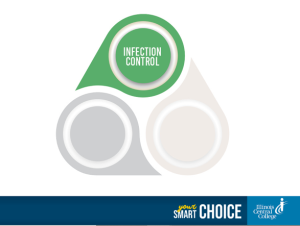
To clean someone’s catheter, perform the opening procedure and practice Standard Precautions. The next step is to gather a basin of warm water and a washcloth. The NA can then have the resident bend their knees and raise their pelvis a few inches from the bed to expose the area for cleaning.
It is important to respect the resident’s dignity and privacy, and only expose the area that is necessary for cleaning. A towel should be placed under the catheter tubing, a bed protector placed between the bed and the person’s buttocks.
Once everything is in place, wet the washcloth and apply soap to it. Gently holding the catheter tubing near the person’s meatus (urinary opening), the clean the four inches of tubing beginning at the meatus and wiping away from it without tugging at the catheter. Wiping away from the meatus, rather than towards it, helps to prevent infection.
Once the area has been cleaned, use a clean washcloth dipped in water to rinse the area, and a third clean washcloth to dry it. Once the area is dry, the NA can dispose of the bed protector and used washcloths, then empty and store the basin.
Chippewa Valley Technical College. (2022, December). Catheter Care. [Video]. YouTube. Video licensed under CC-BY-4.0
Drainage bag
To empty the drainage bag, the perform the opening procedure and practice Standard Precautions. Use a graduate and position it under the drainage bag on the floor atop a paper towel. The drainage bag will empty into the graduate once its clamp is opened. 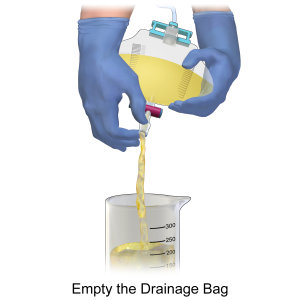
After the urine has drained into the graduate, close the drainage bag’s spout and clean it with alcohol wipes. Next the NA should take the graduate full of urine into the bathroom and place it on a flat surface, letting the urine settle before observing the measurement.
Once the measurement is observed, flush the urine, properly clean and store the container, doff PPE, wash hands, and record the amount of urine according to facility protocol.
Drainage bags are emptied and measured either when they are at capacity or at the end of each nursing shift.
Image by BruceBlaus, CC BY-SA 4.0,
Assistive devices for urination
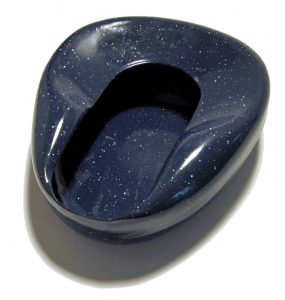
Bedpans look like a toilet seat with a container attached to them, and are used by people who cannot get out of bed. Anybody who cannot get out of bed will use a bedpan for bowel movements, while those who cannot urinate into a handheld urinal will also use a bedpan for voiding.
The person will have to lift their hips long enough for the NA to slide the bedpan under them. NAs must always practice Standard Precautions when assisting someone with elimination.
“Blue Steel Enamelware Bedpan” by VCU Libraries is licensed under CC BY-NC-SA 2.0.
For some people, a bedpan may be too tall to lift their pelvis over. A fracture pan is similar to a bedpan except it is only about ½ inch deep on the side that will slide under a person’s buttocks, so it is easier to use for a person with limited mobility. Fracture pans are used for persons in casts, persons with limited back mobility, after a spinal cord injury or back surgery, after a hip fracture, and following a hip replacement surgery.
Urinals are handheld plastic repositories with an angled opening that a person with a penis can urinate into. NAs should be careful when handling urinals, because they are easy to tip over and if the lid is not securely closed may spill urine. Urinals should never be placed on tables or directly on the bed; they can be placed on the bed rail or on the floor next to the bed. NAs should encourage the person to use the handheld urinal themselves.
Urination equipment should be stored in the bathroom when not in use. If the bathroom is shared, the equipment must be labeled. Bedpans and urinals can also be kept in the bottom section of the person’s bedside stand
When assisting someone with urination in bed, always use a protective pad. Protective pads help keep bed linens dry and prevent the need to change linens whenever a person uses equipment to urinate from bed. Similarly, a towel or protective pad should be used to transport equipment so no urine dribbles or leaks from the container.
Wash hands (both your own and the residents) multiple times throughout the urination process – before, after, and sometimes during. Make sure to complete the closing procedure.
Bowel Elimination
Digestion
The function of the digestive system to receive food, break it down into the elements it is made of, absorb the usable nutrients, and dispose of what isn’t used. Digestion begins in the mouth with the chewing of food and the application of saliva to chemically break down the food. Once the food is swallowed, peristalsis begins[8]. 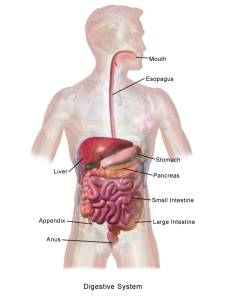
Peristalsis is the contracting motion that the body uses to move food along down the esophagus, into the stomach, and through our intestines. Peristalsis is the reason most humans can swallow while upside down; the contracting motion means that we don’t just have to rely on gravity to keep our sustenance moving along the digestive tract.
The stomach and stomach acid process the chewed and broken-down food into a substance called chyme, which moves along into the intestines where it is either absorbed or becomes waste.
Defecation is the excretion of solid waste once it is processed by the intestines. It is the final stage of the digestive process, and is referred to as bowel elimination. When a person eliminates, they empty their colon of feces, or stool.
BruceBlaus, CC BY-SA 4.0 via Wikimedia Commons
Factors influencing bowel movement
Factors like aging, mental and emotional wellbeing, diet, fluid intake, physical activity, and personal routines can all affect a person’s ability to have healthy bowel movements.
Age: As a person ages their body moves food through their GI tract more slowly. The mechanics of chewing become more difficult, less saliva is produced, and the body absorbs fewer nutrients. NAs can promote normal elimination in aging persons by prompting hydration and encouraging nutrient-dense food choices.
Mental and emotional wellbeing: Privacy and disruptions to routine can have a negative impact on bowel elimination.
When someone is not at home, if they have a roommate for the first time in a while, or factors like anxiety and stress can have a negative impact on bowel movements. The distressing circumstance may make elimination more difficult, produce loose and watery stool, or make somebody need to eliminate urgently.
Diet: Fiber is an important part of a diet conducive to healthy bowel movements, because it helps to hold the stool together. A low-fiber diet can make somebody constipated, and animal fats from dairy, meat, and eggs can also produce constipation. NAs should promote nutritionally dense meals with high quantities of whole grains, fibrous fruits, and vegetables. If the digestive trouble continues, the healthcare team may decide to introduce a probiotic, which is a sample of live bacteria meant to help regulate the body’s digestive system.
Hydration: As a person ages their thirst diminishes, which can result in dehydration and difficult elimination. NAs should prompt residents to drink fluids, and should make sure that their bedside pitcher is always replenished and within reach.
Routines: Personal routines are helpful in maintaining healthy bowel movements. It can be helpful for NAs to prompt residents use attempt a bowel movement at the same time every day; NAs should give residents about 15 – 20 minutes per attempt. Encouraging the resident to consume warm fluids can also stimulate elimination.
People who are on medications that cause constipation may be prescribed laxatives or probiotics to help their bodies manage the digestive side effects of their medication.
Healthy elimination
Stool is usually brown in color, soft, moist, and holds its shape. Stools vary in color depending on the diet of the person, their medications and supplements, or whether they are ill. Stool that is small and hard is difficult to pass and indicates a need for more hydration. Stool that is mostly liquid is called diarrhea, and indicates a need for more fiber or another intervention depending on the cause of the diarrhea[9].
NAs should observe patients’ stool for any signs of unwellness. Report to the nurse immediately if the resident experience:
- stool that is bloody or discolored
- stool that is hard and dry
- liquid stool
- stool containing discharge such as pus
- the person reports pain when eliminating
Such symptoms indicate a need for further assessment and follow up. When a resident defecates, ask them not to flush until you’ve had a chance to look at their stool.
Common bowel problems
Some common bowel problems include constipation, fecal impaction, flatulence, diarrhea, incontinence, and gastrointestinal bleeding.
Constipation occurs when somebody has difficulty
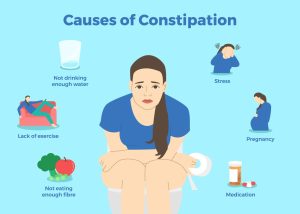 eliminating stool. When somebody is constipated, their body waste moves very slowly through their digestive system, resulting in feces that are hard and dry and difficult to pass.
eliminating stool. When somebody is constipated, their body waste moves very slowly through their digestive system, resulting in feces that are hard and dry and difficult to pass.
Constipation may be caused by aging, poor diet, lack of activity, low fluid intake, and other factors. If somebody is constipated it can cause gassiness, abdominal discomfort, and irritability.
Image by Click2pharmacy.co.uk Images is licensed under CC BY 2.0
Treatments for constipation start with lifestyle changes in the areas of diet (more fiber), fluid intake (more water), and activity (more exercise). If these less invasive interventions are impossible or ineffective, the doctor may order stool softeners, laxatives, or medication in the form of rectal suppositories.
Fecal impaction is a total inability to pass waste. Feces build up in the rectum. These feces are hard and cause liquid stool to ooze from the anus.
Some symptoms of fecal impaction are abdominal distention (swelling), pain and cramping, and no stool for multiple days.
Fecal impactions cannot be removed by the person on their own, and require a digital exam to diagnose. NAs should report signs of possible fecal impactions immediately. If left untreated, fecal impactions can become extremely severe, resulting in fever, disorientation, and even death. Impactions can be prevented with hydration, exercise, high-fiber foods, and a regular elimination schedule.
Flatulence refers to passing gas, and occurs when gas builds up in the digestive tract and is released. Some flatulence is normal, but excessive flatulence may indicate an intolerance to certain foods, excess dietary fiber, nutrient malabsorption, or irritable bowel syndrome (IBS).
Increased activity levels can help with constipation and flatulence because it promotes digestion, increases thirst, and helps a person stay physically relaxed.
Diarrhea is the frequent passage of liquid stool. Diarrhea is caused by any number of things from dietary disturbances, medications, and illness. Diet changes and drugs are prescribed to harden stool and reduce peristalsis.
NAs will surely care for somebody experiencing diarrhea, likely with some regularity. When caring for somebody with diarrhea, always respond to call lights immediately, since a person may not have much time between realizing they need to go and going. If the person is using assistive equipment to eliminate while in bed, NAs should dispose of stools as quickly as possible.
Diarrhea is highly irritating to skin, and can lead to skin breakdown, pressure ulcers, and infection. Remember to give excellent skin care when a person experiences diarrhea, with special attention to the impacted areas.
Diarrhea contains higher water content than regular feces, which means that a person experiencing diarrhea will lose more water through defecation than they would otherwise. NAs should encourage people experiencing diarrhea to hydrate so they can replace the fluids lost through diarrhea.
Gastrointestinal bleeding is any bleeding along the GI tract. The symptoms of GI bleeding will show up in a person’s stool. Bleeding in the stomach and small intestine causes black or tarry stool. Bleeding in the lower colon and rectum causes red-colored stools. If NAs notice any discoloration in residents’ stool they should report it immediately and record it in the resident’s chart.
Fecal Incontinence
Fecal incontinence is the inability to control the passage of feces through the anus[10]. The involuntary elimination of feces has a negative emotional impact on a person; it can rob a person of independence and personal empowerment. Frustration, sadness, anger, humiliation, and embarrassment are common and understandable responses. NAs must always respond to people experiencing fecal incontinence with kindness, compassion, empathy, and patience.
The causes of incontinence include intestinal disease, nerve damage and injuries, fecal impaction, diarrhea, drugs, illness, dementia or other mental health problems. Other causes of fecal incontinence include not being able to get oneself to the bathroom in a timely manner, not receiving timely assistance with elimination if one requires it, and not being able to locate the bathroom when confused or in a new setting.
The goal treatment for fecal incontinence is to return a person’s bowel control to normal functioning, or as close as possible to normal functioning. Treatment for incontinence may include bowel training, changes in diet, or even surgery.
A person experiencing incontinence may use incontinence briefs and other products to keep their garments and linen clean when they have an uncontrolled bowel movement. NAs should respond to peoples’ call lights right away when they are experiencing incontinence; changing incontinence briefs quickly is essential to maintaining a person’s skin health and overall wellbeing.
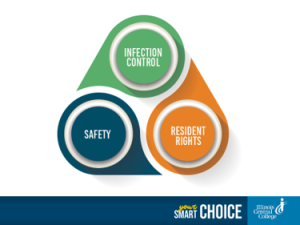
All three aspects of the Big Three must be kept in mind while caring for people experiencing incontinence. Residents have a Right to timely care and to dignity, which precludes them being permitted to sit in their own feces. Infection control is paramount, since people with incontinence are more likely to develop skin breakdown and pressure ulcers. Safety matters too, since somebody with incontinence may attempt to get themselves to the bathroom quickly when they really ought to be assisted.
Treatments for fecal incontinence
Bowel training
Bowel training is one tool that a care team can use to help a person experiencing fecal incontinence. The goals of bowel training are to help a person gain control over their bowel movements and to get someone on a regular elimination schedule. Bowel training involves taking the patient to the bathroom at specific times every day. NAs must always follow the care plan carefully and consistently. Recording observations of when a person needs to use the bathroom and the quality of their stool will be an essential part of bowel training.
NAs must always be respectful, kind, and positive, especially when a person experiences an episode of incontinence. Becoming frustrated or angry with somebody when they have an episode of incontinence, or when they take a long time to use the bathroom, is abusive and cannot be tolerated. Additionally, if caregiver reactivity becomes a source of anxiety or worry for somebody experiencing incontinence it can hurt their treatment outcomes. If a NA notices somebody engaging in this type of behavior, they should alert the nurse.
Other factors in someone’s treatment for fecal incontinence may include a high-fiber diet, increased fluids, drinking warm fluids, increased activity levels, and ensuring privacy. Different residents will respond to different things; NA should pay attention to people as individuals to best determine what they need and how they can be helped most effectively.
Suppository
A suppository is a cone-shaped drug that is inserted into a body opening. When a suppository is inserted into the body through the rectum it is called a rectal suppository.
When somebody needs a rectal suppository in order to defecate, a bowel movement will usually occur about 30 minutes after insertion. Doctors may order a rectal suppository to stimulate a bowel movement for persons experiencing constipation, fecal impaction, or to promote a bowel training schedule.
Enema
An enema is a cleansing of the colon with water or another liquid solution to stimulate a bowel movement. NAs are allowed to give enemas in some facilities after they have been trained on the procedure – NAs should always ask further questions if they are unsure about a delegated task. Enemas are given to relieve constipation, impaction, or flatulence. They are also given in preparation for surgery or for the performance of a diagnostic test.
Enemas are either given with tap water, soapsuds, saline, or a prepared commercial solution. For tapwater, saline, and soapsuds enemas, 500 – 1000 mL of water is used, with either no additives, two tea spoons of salt, or 5 mL of castile soap added depending on the type of enema. A commercial enema will be 120 mL of a prescribed solution[11].
When a tap-water enema is given the enema should not be repeated. However, if a saline or soapsuds enema is ordered the doctor may order that enemas be repeated until the liquid solution is clear and free of stools when it exits the rectum. An enema usually takes about 10 – 20 minutes to perform. The person receiving the enema will be in the left side-lying position throughout.
To give an enema, NAs should make sure they perform the opening procedure, practice Standard Precautions, and communicate with the person throughout the whole process. Once the enema solution is prepared in the IV bag and the person is in position, the NA should lubricate the tip of the tubing before inserting it 2 – 4 inches into the person’s rectum. Do not continue if the person feels pain or if the tubing encounters resistance in the rectum – if this occurs, the NA should tell the nurse immediately.
The solution should be administered slowly and will take 10 – 15 minutes for 750 – 1000 mL of fluid. The temperature of the enema should be roughly body temperature, and must not exceed 105-degrees Fahrenheit. NAs can help the person stay comfortable by encouraging deep and regular breaths, and making light conversation to pass the time. The tube should be clamped and the flow stopped before the bag is empty, so no excess air gets into the bowels.
The person should hold the solution in as long as they can. The NA should make sure the bedpan is immediately available or that the pathway to the person’s bathroom is clear and safe. NAs should make sure to provide proper perineal and skin care following an enema.
RegisteredNurseRN. (2014, August 8). How to Give a Soap Suds Enema Administration [Video]. Youtube. https://www.youtube.com/watch?v=iJvKxxn40zE
Ostomies
Ostomies are surgically created openings in the body that allow for things inside the body to exit through a surgically created path; the tissue surrounding the opening itself is called a stoma. Sometimes a person with an illness that impacts the bowels will require an ostomy to expel waste.
- A colostomy is an ostomy between the colon and the abdominal wall. It allows for the expelling of stool into an ostomy bag. Stool from colostomies will usually be semi-solid. Colostomies can be temporary or permanent; if somebody has their colon removed, they will require a permanent ostomy.
- An ileostomy is an opening made in the small intestines that leads outside the abdominal wall. Stool from an ileostomy will look more liquid and have a somewhat foul smell.
Ostomies use a two-piece system: there is the ostomy pouch, which carries the waste once it is eliminated, and there is the skin barrier that seals the stoma (ostomy opening) from the outside and prevents leaking.
Good skin care is paramount for persons with an ostomy. The stool that ostomies help a body expel is highly irritating to the surrounding skin. NAs should closely observe the area around an ostomy for signs of skin breakdown. The ostomy equipment will be changed every 5 – 7 days.
Lecturio Nursing. (2023, January 7). Ostomy Care: Assessing The Stoma and Providing Skin Care | Lecturio Nursing Clinical Skills [Video]. Youtube. https://www.youtube.com/watch?v=H7rMVzXaOb4
Collecting Specimens
A specimen is a sample of something like blood, tissue, urine, or feces. Doctors may order a specimen be collected; if the order is for a urine or stool specimen, the task will likely be delegated to the NA. All specimens are labeled with at least 2 forms of ID (name and identification number), as well as the date and time of collection.
Once waste specimens are sealed in their appropriate container, they must also be bagged in a bio-hazard bag. Waste samples are considered highly contaminated, and NAs should wear gloves and practice Standard Precautions while collecting and transporting the sample. If specimens need to be stored before being taken for testing, they will be placed in a specific refrigerator; never place stool or urine specimens in the same refrigerator as food.
Stool specimens
Stool specimens are collected using a device called a hat. Hats, in this context, are cups with wings that sit beneath a toilet seat and catch the stool before in reaches the toilet basin. They look like an upside-down top-hat.
When someone has an order for a stool specimen, the NA should make sure the person lets them know when they are about to have a bowel movement. The NA can then set up the hat on either the toilet or the bedpan, and allow the person privacy to do their business (always practice Standard Precautions throughout).
Once the person has completed their bowel movement, the NA can assist them with cleaning up. After washing hands and with a new pair of gloves, the NA can then then take a wooden tongue blade or disposable spoon and transfer about two tablespoons of stool from the hat to the specimen container and screw the cap closed before placing the specimen container in the biohazard bag for transport.
The wooden tongue blade should be wrapped in a paper towel before being disposed of in the proper bin. The rest of the equipment should then be cleaned and stored in the proper place. The specimen can then be taken to the lab for analysis[12].
Urine specimens
NAs will collect urine specimens; there are a few different kinds of urine specimens that can give the care team different sorts of information on what is happening in a person’s body[13].
A routine urine specimen is a specimen that can be collected any time the person urinates. A routine urine specimen is collected using a hat or a bedpan. After performing the opening procedure and getting the supplies ready, the NA should let the person have some privacy. Once they are finished, assist them with perineal care and transfer urine from the hat or bedpan into the specimen collection container before discarding the remaining urine into the toilet.
A fractional urine specimen is collected much the same way that routine urine specimens are collected, except they must be collected within a specified time frame. A routine urine specimen can be collected at any time, but a fractional urine specimen must be collected within the time window specified in the doctor’s order.
A clean catch specimen or a mid-stream specimen is a urine sample that does not include the first or the last urine during voiding. Perineal care is provided before the sample collection.
Set up the specimen collection kit in a similar way to a routine specimen, except the person should void a little bit before the specimen collection begins. Once the person initially voids in the toilet or bedpan, they should pause and let the NA place the specimen collection container beneath their stream. The person can then begin urinating again, and should continue until the specimen container is at least ½ full.
Once an adequate amount of urine has been collected, remove the container and let the person finish voiding. After wiping the urine container with a paper towel and placing it in the biohazard bag, assist with perineal care as needed before making sure they are comfortable and leaving with the sample.
A 24-hour urine specimen is a collection of all the urine voided by a person in a 24-hour period. The collection will usually begin at 7 a.m. and last until 7 a.m. the next day. A person should begin the collection process with an empty bladder, which means the NA should ask them to void right when the collection starts and then discard the first urine. Take care to store and label the urine sample properly as it is it being collected; if any of the sample is mishandled, spilled, or improperly stored, the 24-hour collection window will start over.
When collecting a 24-hour urine sample, perform the opening procedure and check in with the resident. There should be a sign placed on the person’s bedside stand; signs may read something like “24-hour urine specimen collection in process, save all urine.” Once everything is in place, the resident will void once. The NA should mark the amount and exact time of the first voiding, and discard it so it is not included in the sample.
Standard Precautions must be used every time the NA collects urine samples and adds them to the container. The urine from the bedpan, urinal, or hat will be added to the container upon voiding. Store 24-hour specimens according to facility guidelines, usually refrigerated or over ice. Follow instructions closely and always ask follow up questions if unsure about something. Once the 24-hour period is up, add the final void to the container and remove the sign.
Resident Rights and comfort
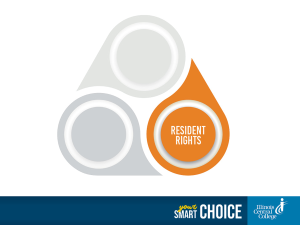
Having urine and stool specimens collected can make someone feel embarrassed. NAs should always be professional and friendly when collecting specimens, and can make casual conversation to help put the person at ease.
Always explain the procedures clearly and comprehensively to the person, and continue to narrate care as you give it; keeping someone informed about their care in the moment can help calm anxious feelings, and is a good way to practice person-centered care. NAs must always provide privacy, dignity, respect, and autonomy is all aspects of their care, including (perhaps especially) those dealing with a person’s stool and urine.
Key Takeaways
- Healthy urination involves the purposeful voiding of about 1500 mL per day of clear pale-yellow urine. Adequate hydration and activity levels are important for maintaining urinary health. When someone experiences urinary incontinence, it means that they cannot always control when they void and may urinate at times when they do not expect to. Always respond to call lights from incontinent residents as soon as possible.
- When caring for a person with a catheter, begin with a lightly soapy washcloth and clean 4 – 5 inches of catheter tubing beginning at the urinary opening and wiping away from the urinary opening every time. Always wiping away from the urinary opening is an important part of infection control; wiping towards the urinary opening may push pathogens toward the urinary tract, rather than away from it.
- When someone has healthy bowel movements, their stool will be brown and soft, but will still hold its shape. Excessively watery stool is called diarrhea, and stool that is hard and dry can cause constipation. Constipation occurs when someone cannot, or has difficulty attempting to, pass stool. Some common causes of constipation include dehydration, lack of dietary fiber, and age. Fecal incontinence is when someone may eliminate stool uncontrollably; someone experiencing fecal incontinence may use incontinence briefs to manage their symptoms.
- Always practice excellent skin care with incontinent residents. Answer their call lights immediately, and assist with skin and perineal care frequently.
- Follow instructions carefully when collecting a stool or urine sample. Make sure that you follow the correct process for the sample ordered.
Comprehension Questions
1) The function of the kidneys is too …
a. Carry the urine until the person is ready to void
b. Connect to the ureter
c. Filter nutrients and minerals from fluids, and turn the waste into urine
d. Keep the bladder clean
2) What are some qualities of healthy urination?
a. Urine is faintly cloudy
b. Urine is clear and pale yellow in color
c. Producing roughly 500 mL of urine per day
d. Voiding is painless
e. Urination occurs every 30 minutes
3) Respond to the following sentences with T (true) or F (false).
____ Urinary health is impacted by emotional wellbeing.
____ As someone ages they usually develop stronger urinary muscles and better control.
____ Swelling in the hands and feet is a sign that the urinary system is working as it should, especially when the person is being treated for incontinence.
____ One way NAs can help prevent UTIs is by responding to bathroom requests immediately.
____ Oliguria refers to producing abnormally large amounts of urine.
4) How should nursing assistants respond to a resident who has an episode of incontinence?
a. Change any wet linens, clothing, or incontinence briefs immediately
b. Politely suggest that the resident just holds it until a staff member can get there next time
c. Insist to the nurse that the resident use an indwelling catheter
d. Provide perineal and skin care to the impacted area to prevent rashes and skin breakdown
5) What are some practices NAs should use when providing care to someone with a catheter?
a. Place the drainage bag higher than the person so it fills up at the right speed
b. Always use Standard Precaution and excellent infection control measures
c. When providing perineal and catheter care, place a towel beneath the person’s buttocks
d. If the person complains of discomfort, NAs can temporarily remove the catheter to give the person some reprieve
6) What is a bedpan?
a. A pan that residents can use to cook some or all of their meal from bed if they want to. This promotes independence and self-esteem
b. A handheld plastic container residents can urinate into, used for people who cannot get out of bed
c. A device that looks like a container with a toilet seat attached to it, used for people who cannot get out of bed
d. An area under a resident’s bed for storing devices related to elimination
7) Please list at least three signs or symptoms of unhealthy stool that should be reported.
8) If a resident experiences fecal incontinence, which of these elements of their diet may be increased?
a. Milk and yogurt
b. Fowl, such as chicken
c. Fruits and whole grains
d. Coffee
9) Respond to the following sentences with T (true) or F (false).
____ A constipated person usually has diarrhea and uncomfortable defecation.
____ Fecal impactions can be diagnosed by gently feeling for lumps around the person’s anal region; only doctors or nurses can diagnose fecal impaction.
____ Persons experiencing diarrhea should be prompted to hydrate.
____ Enemas cleanse the colon with water or a water solution; NAs may be responsible for administering enemas.
____ Ostomies tend to promote skin health.
10) When collecting a 24-hour urine specimen, NAs should …
a. Collect the first void, record the amount, and include it in the 24-hour total
b. Place a sign by the person’s bed alerting staff that a 24-hour collection is in process
c. Use Standard Precautions
d. Store the urine specimen in a warm and sunny corner of the resident’s room
11) Why is it important that nursing assistants express patience and kindness when residents experience incontinence? Think of your answer in terms of the Big Three. How might a negative caregiver reaction to an episode of incontinence produce negative health outcomes for the resident in the future?
12) A resident’s call light went off once an hour ago, but you were helping another resident finish their meal. By the time you were done, the call light was off and you assumed that another staff member had responded to it. When you go into the first resident’s room, you see that she has soiled herself and has been sitting in urine-soaked sheets for about an hour. When you asked why the call light hadn’t been on, the resident said “Oh, I just didn’t want to bother you and I knew you would get here eventually.” How were the Big Three violated in this situation? How would you respond to the resident in this moment? What could you have done to prevent this situation from occurring?
- National Institute on Aging. (2022, January 24). 15 Tips to keep your bladder healthy. https://www.nia.nih.gov/health/15-tips-keep-your-bladder-healthy ↵
- Nursing Assistant, Chapter 11 by Chippewa Valley Technical College is licensed under a Creative Commons Attribution 4.0 International License, except where otherwise noted. ↵
- Dugan, D. (2020). Nursing assisting: A foundation in caregiving (5th ed.), Chapter 16. Hartman. ↵
- Image by Lari Labello is licensed under CC BY 4.0 ↵
- Mayo Clinic. (2023, February 9). Urinary incontinence. Mayoclinic.org. https://www.mayoclinic.org/diseases-conditions/urinary-incontinence/symptoms-causes/syc-20352808 ↵
- Nursing Assistant, Chapter 5 by Chippewa Valley Technical College is licensed under a Creative Commons Attribution 4.0 International License, except where otherwise noted. ↵
- MedLine Plus. (n.d.). Urinary catheters. MedLine Plus Medical Encyclopedia. https://medlineplus.gov/ency/article/003981.htm ↵
- Dugan, D. (2020). Nursing assisting: A foundation in caregiving (5th ed.). Chapter 15. Hartman. ↵
- Nursing Assistant, Chapter 11 by Chippewa Valley Technical College is licensed under a Creative Commons Attribution 4.0 International License, except where otherwise noted. ↵
- Sorrentino, S. A., & Remmert, L. N. (2019). Mosby's essentials for nursing assistants (6th ed.), Chapter 22. Elsevier. ↵
- Saga, S., Seim, A., Morkved, S., & Vinsnes, A. G. (n.d.). Bowel problem management among nursing home residents: a mixed methods study. In BMC Nursing. https://doi.org/10.12968 (Reprinted from BMC Nursing, 2014,, 13[35]) ↵
- Sorrentino, S. A., & Remmert, L. N. (2019). Mosby's essentials for nursing assistants (6th ed.), Chapter 26. Elsevier. ↵
- https://www.questdiagnostics.com/healthcare-professionals/test-directory/specimen-handling/urine-collection. ↵
Urinating
Inability to control elimination
Painful urination
Bloody urine
Excessive night-time urination
Voiding abnormally large quantities
Producing very little urine
Enlarged prostate
Kidney infection
Kidney stones
A tube inserted into a person's body to easily give fluids, like hydration, or take fluids, such as blood and urine
The part of a catheter system into which fluids removed are stored
A urinary catheter that remains inserted into the bladder for extended periods of time, and is held there by a small balloon.
A urinary catheter that is fitted onto the penis and does not require insertion
The steps NAs go through every time at the beginning of the care process, including introducing themselves, verifying the resident's identity, and performing hand hygiene.
Minimum standard of caution when interacting with a person's body fluids. It assumes that all bodily fluids carry an infectious pathogen and treats them as such.
The external opening through which a person urinates, and into which a catheter is inserted.
The steps followed every time after completing a care task, including performing hand hygiene and making sure the resident is comfortable.
The contracting motion of the muscles along the digestive tract that continuously push matter through the digestive system
Feces. Healthy stool is brown, soft, moist, and is able to hold its shape.
Liquid stool
Difficulty or inability to eliminate waste
Medication that stimulates bowel movement
Medication that is administered via insertion into the rectum
A total inability to pass waste due to a fecal blockage
Defecation at regular intervals to get a body into the habit of going at particular times
Cleansing the colon with water
Surgically created openings that allow for things inside the body to pass to the outside
A surgically created opening in the colon that allows for stools to exit the body and bypass the colon
